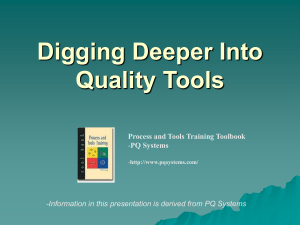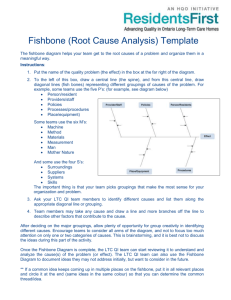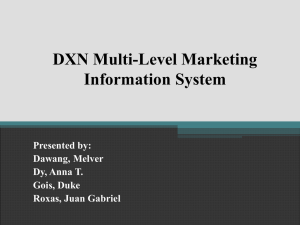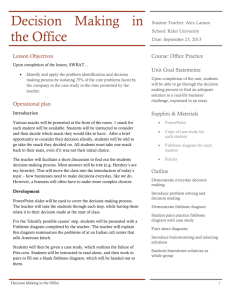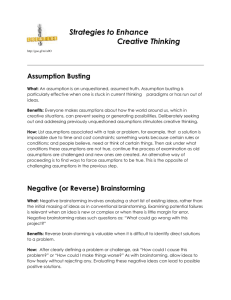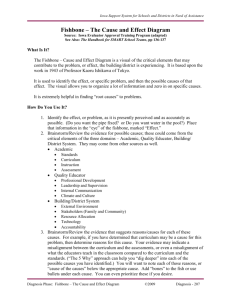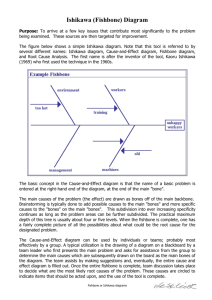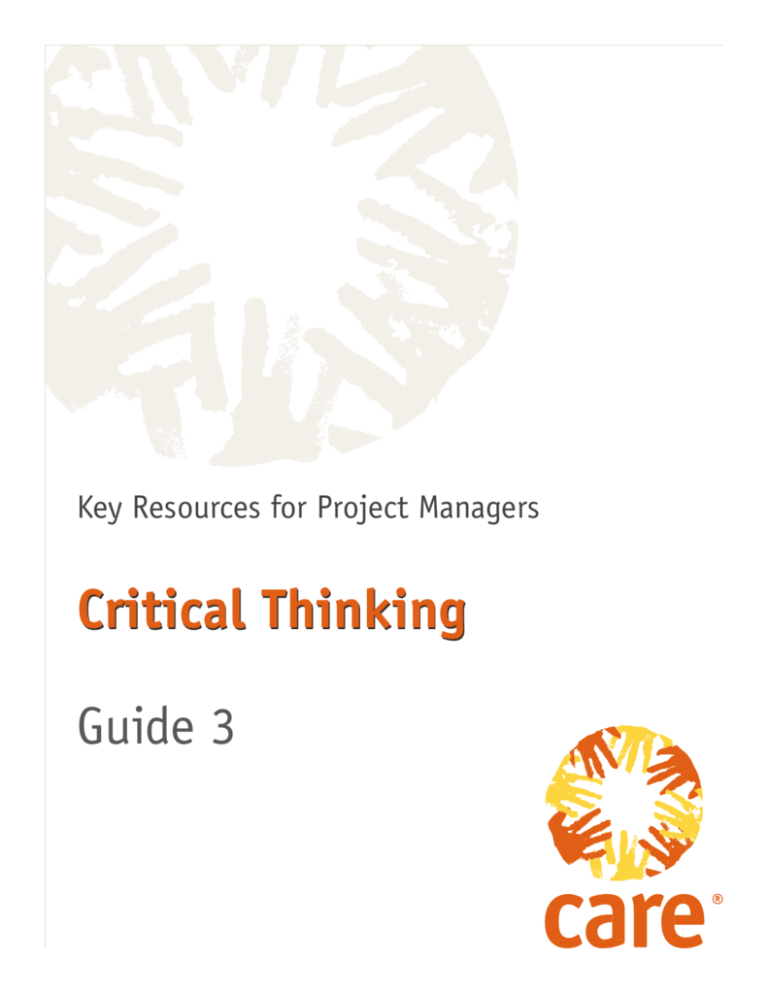
Key Resources for Project Managers
Critical Thinking
Guide 3
Key Resources for Project Managers
Guide 3
Critical Thinking
Reference
About this Guide
The Critical Thinking Guide is intended to serve as a reference for you, the new project
manager, and to give you basics of an essential skill for managing projects at CARE. The
larger Guide is divided into two parts: a reference and a self-study.
The reference is organized in chapters so you can access the information you need
quickly. The self-study section contains two parts, a check for understanding and an
application to the job.
Copyright ©2009 by Cooperative for Assistance and Relief Everywhere, Inc. (CARE). All rights reserved.
Key Resources for Project Managers
Table of Contents
Introduction ........................................................................................................... 1
The Basics of Critical Thinking ................................................................................. 2
The Critical Thinker ......................................................................................................... 2
Critical Thinking and Project Management .......................................................................... 3
Problem Solving...................................................................................................... 4
Problem Solving Defined .................................................................................................. 4
Tools for Problem Solving ........................................................................................ 7
Ask “Why?” 5 Times ........................................................................................................ 7
Fishbone (Cause and Effect Diagram) ................................................................................. 8
Force Field Analysis....................................................................................................... 10
Finding the Help You Need............................................................................................. 12
Resources .................................................................................................................... 13
Key Resources for Project Managers
Critical Thinking
Questions Answered
In the Critical Thinking Guide, you will find answers to
the following questions:
• What is critical thinking and how is it linked to
problem solving?
• Why is critical thinking essential to project
management?
• What are the key steps in problem solving?
• What tools can I use to help with problem solving?
Key Resources for Project Managers
Chapter 1
Introduction
Your work as a project manager is fast-paced and varied. Not only do you have
direct reports to manage, but to achieve results you must work effectively with other
staff, governments, partners, grantees, and the community. All of these groups
must carry out their work in accordance with the project plan, implementation
schedule and budget. Anticipating needs, overcoming resistance, and building
common understanding are essential to the project’s success.
Critical thinking is an essential skill for successfully implementing a project from
award approval to project closure. Though this skill may come more naturally for
some than for others, it is one that can be continuously developed and
strengthened. As a project manager, you will use critical thinking to:
• Understand and use new information
• Identify, evaluate and solve problems
• Make sound decisions
In this Guide you will learn what critical thinking is and why it is important to your
job as a project manager. You will also gain a basic understanding of problem
solving, which is at the heart of the critical thinking process. Finally, you will
receive some tools that you can use to solve problems you encounter while managing
your project.
Critical Thinking Guide
Page 1
Key Resources for Project Managers
Chapter 2
The Basics of Critical Thinking
Critical thinking is the process of identifying and evaluating evidence in order to
make an appropriate decision. This evidence can be gathered by observation,
experience, research, reasoning, or conversation with others. The critical thinker
uses a logical analysis of evidence to make decisions and to communicate his or her
decisions clearly.
Critical thinking is a process of thinking that examines a situation in an objective
manner. Critical thinking is the application of excellent problem-solving skills.
The Critical Thinker
Four problem-solving steps ensure that the right questions are asked in order to
arrive at the best solutions:
1. Identify the problem
2. Develop potential causes
3. Identify the most likely cause
4. Decide upon and implement action plans
During the problem-solving process, the critical thinker:
• Asks key questions in a clear and precise manner
• Collects and evaluates relevant information
• Arrives at well-reasoned conclusions and tests them against applicable criteria
• Communicates effectively with others to find solutions to complex problems
• Thinks open mindedly and recognizes and assesses assumptions, implications,
and practical consequences
Page 2
Critical Thinking Guide
Key Resources for Project Managers
Critical Thinking and Project Management
Critical thinking is an essential skill for all aspects of project management at CARE.
The skill helps you organize your thoughts, analyze pros and cons of a situation, and
present conclusions in a concise and persuasive manner.
As a project manager, you use critical thinking to anticipate problems, plan, resolve
issues, and ensure that all team members know what to expect and what to do.
Essentially, critical thinking is about:
• Using evidence skillfully and impartially
• Organizing thoughts and expressing them well in speech and in writing
• Suspending judgment in the absence of sufficient evidence to support a
decision
• Questioning and asking “Why?” as the project unfolds
• Thinking ahead and determining potential outcomes based on facts
For example, during the project planning phase, you might ask yourself:
• How do I localize the donor plan and make the best use of my resources?
• What needs to be in place and by when?
• Who needs to be informed of changes?
• Who needs to be a partner in the project?
• What issues might arise from the political climate that will need to be
addressed in order to establish common objectives and activities?
Even when best efforts are made to evaluate the situation before making a decision,
you may encounter unexpected events. In this case, you need to reassess the
situation, re-evaluate, make a different decision and implement accordingly. Ideally,
you should not wait for a problem or event to occur before taking action.
Critical Thinking Guide
Page 3
Key Resources for Project Managers
Chapter 3
Problem Solving
Problem solving is an essential skill for critical thinking. When employed as part of
your thinking strategy, this skill can transform broad and general issues into specific
areas that lead to desired outcomes. This chapter gives you some concepts and
principles that enable you to solve problems more effectively.
When you seek a solution to a problem, you are, in essence, trying to answer these
key questions:
• What are the specific issues that require your attention?
• What logical approach or strategy is best to address each issue?
• What is the priority for addressing each issue according to importance?
Remember:
A problem well-stated is a
problem half-solved.
Charles F. Kettering
When you use problem-solving skills to answer
these questions, you are able to transform
general and vague concerns into specific, factual
issues.
Problem Solving Defined
When you are problem solving, you are selecting, organizing, and evaluating
information that determines the root causes of a problem. As a project manager,
your knowledge of the cause of a problem is key to determining what should be done
to address it. Let’s take a scenario.
During an office visit, a project manager notices that a field coordinator's organizational
timetable is not displayed on the office's notice board. The project manager quickly
assumes the cause to be improper attention to office procedures regarding the timetable.
Page 4
Critical Thinking Guide
Key Resources for Project Managers
Based on this assumption, she decides to reprimand the field coordinator and institute
additional procedures to ensure permanent display of the timetable.
Now let’s analyze this scenario:
Is the project manager right in her assumption? What if the true cause of the
problem was a migration from hard copy to electronic? Or perhaps there was an
existing team conflict and another team member removed the timetable? If either of
these is the true cause, the existing timetable procedures were not improper. The
reprimand and additional paperwork would fail to correct the problem and would
cause the field coordinator to resent the project manager.
Systematic Process
It is important that you analyze an issue to
determine the real cause of the problem before
deciding on appropriate corrective action. To be
effective in problem solving, it is important to
follow a systematic process, which consists of four
steps.
Remember:
Problems are opportunities to
learn more.
1. Identify the problem
Describe the problem clearly. You need to decide what you want to achieve
and write it down. Often people keep the problem in their head as a vague
idea, and it can get lost or others will not be able to help in the solution.
Writing down the problem forces you to think about what you are actually
trying to solve.
2. Identify potential causes
Focus on the problem, and write down all possible causes, whether they sound
reasonable or not. Ask yourself, “What are the possible contributing factors?”
Generate as many ideas as possible and withhold evaluation of any one idea,
just write them all down. Invite team members and others to give their
thoughts on possible causes.
3. Identify the most likely cause
In this step, you might investigate factors within each of the potential causes.
You can write down the good and bad points for each of the causes identified,
and you might consider gathering more information about each.
Even at this step, you are not evaluating the causes. You are simply reviewing
and discussing the points of each. This step helps you get at the root cause of
the problem and address the question, “What are the specific issues that
require your attention?”
Critical Thinking Guide
Page 5
Key Resources for Project Managers
4. Decide upon and develop action plan
In this step you decide the most likely cause of the problem based on your
research and discussions. After you have pinpointed the most likely cause or
root cause, you can then decide on the most appropriate solution.
Sometimes pure facts and figures dictate which solutions will work and which
will not. Sometimes the decision is based on lifetime experience and
judgment.
Work with your project team to plan the actions
that will address the problem. This plan might
be based on the available people, time, and
money. Action plans should clearly define who
does what and by when.
When you complete this step, you should have
the answer to the questions “What logical
approach or strategy is best to address each
issue?” and “What is the priority for addressing
each issue according to importance?”
TIPS
• Remember we all face
problems every day
• Solve problems as
soon as possible
• Use a team approach
to solve problems
These steps and tips will help you analyze, assess, and improve your thinking as you
manage projects and staff within our organization.
Page 6
Critical Thinking Guide
Key Resources for Project Managers
Chapter 4
Tools for Problem Solving
Some people find that it is helpful to use a tool to help identify issues or causes.
The tools keep the focus on the content of the problem, not the history of the
problem or the differing interests of team members. Ideally, using these tools also
creates a snapshot of the collective knowledge and consensus of a team around a
problem, as well as builds support for the resulting solutions.
If you want to use a tool, here are several to choose from. Each one will help you
analyze the problem for clarity and action. The tools are:
• Ask “Why” 5 Times
• Fishbone (Cause and Effect Diagram)
• Force Field Analysis
• Finding the Help You Need
You should use these tools when you want to:
• Identify causes
• Identify the most likely cause
• Determine actions to take
Ask “Why?” 5 Times
Ask “Why?” 5 Times is a simple problem-solving technique that helps you get to the
root of the problem quickly. This technique involves looking at a problem and
asking, "Why did this problem occur?” Then, focusing on that answer, you again
ask, “Why did this occur?”
Critical Thinking Guide
Page 7
Key Resources for Project Managers
In this way, the answer to the first "why" prompts another "why," and the answer to
the second "why" prompts another, and so on — hence the name Ask Why 5 Times.
By asking these questions, you can quickly determine the root cause of a problem.
To use this technique, you start with your problem statement and ask “Why?” Then
you answer that question and continue asking "Why?" You should repeat the
“Why?” at least five times, or until the root cause of the problem becomes apparent.
Example
Following is an example of the 5 Why’s in action:
1. Why is the village unhappy? Because we did not deliver our services when we said we
would.
2. Why were we unable to meet the agreed-upon timeline or schedule for delivery? The
job took much longer than we thought it would.
3. Why did it take so much longer? Because we underestimated the difficulty of the job.
4. Why did we underestimate the difficulty of the job? Because we made a quick
estimate of the time needed to complete it, and did not list the individual actions and
time needed to complete the project.
5. Why didn't we list actions? Because we were running behind on other projects. We
clearly need to review our time estimation and specification procedures and reassess
our project.
The 5 Why’s technique is an easy and effective tool that can be adapted quickly and
applied to most any problem. If these questions do not prompt an intuitive answer,
however, other problem-solving techniques may need to be applied.
Fishbone (Cause and Effect Diagram)
The Fishbone, or Cause and Effect Diagram, is a tool that helps you clarify causes. It
allows you to identify, explore, and visually display all of the possible causes related
to a problem in order to discover its root cause(s). This tool keeps the focus on the
causes of the problem, not the symptoms.
The Fishbone is best used with a group of people, such as your team. At each step,
make sure everyone agrees — on the problem, the categories, and the possible
causes.
Page 8
Critical Thinking Guide
Key Resources for Project Managers
Creating the Fishbone
The Fishbone tool looks like the spine of a fish, with a backbone and ribs. Each rib is
labeled with a category of causes. You should pick categories that fit the specific
problem that you are working on.
You need a large, blank piece of paper like a flipchart or butcher paper. As you
write, make sure the chart and words are large enough to be seen by everyone
present.
Here is how you create a Fishbone:
1. Draw a long, straight line as the “backbone” of the fish horizontally across the
page.
2. Add an “Effect” box at the right end of the “backbone.”
3. Add four to six “ribs” off each side of the “backbone.” Leave adequate room on
either side of each “rib” so you can write causes. (You may need longer paper
for a six-fin fishbone.)
4. Put a “Cause” box at the end of each branch.
When you have your fishbone skeleton, it should look something like this:
Using the Fishbone to Solve a Problem
To use the Fishbone to solve a present problem, you:
1. Write the problem you want to analyze in the “Effect” box.
2. In each Cause box, write the name of a category of probable causes for this
problem.
Useful categories include People, Equipment, Methods, Materials, or others
such as Money or Information. Be thoughtful and flexible in assigning these
categories because they will vary depending on the project or situation.
Critical Thinking Guide
Page 9
Key Resources for Project Managers
3. Brainstorm all the possible causes you can think of under each category,
branching them off each rib. Usually, you write the causes on lines or
branches drawn off of the rib.
4. When you have completed the Fishbone, consider which cause has the biggest
impact on the problem. That is probably your root cause.
Below is an example of the Fishbone used to identify the causes of a late delivery:
Force Field Analysis
The Force Field Analysis tool can be used to identify causes and determine action.
This tool, which was developed by social psychologist Kurt Lewin, is a simple
technique for identifying the factors that support or work against your proposed
solution.
In the Force Field, the current situation, or status quo, is held in place by opposing
forces:
• Driving Forces — the actions or people that are helping you most to achieve
the goal
• Restraining Forces— those actions or people that are resistant to achieving the
goal
If you can alter the forces, the situation will change. In many instances, removing
some restraining key forces will have a significant impact on achieving the goal.
Page 10
Critical Thinking Guide
Key Resources for Project Managers
Creating the Diagram
The Force Field looks like a T-diagram with branches off of each side of the center
line. On a large sheet of paper, do the following:
1. Draw a large letter “T” in the center of the paper.
2. At the bottom of the “T,” write the words “Status Quo.”
3. On the left side of the top of the “T,” write “Driving Forces.”
4. On the right side of the top of the “T,” write “Restraining Forces.”
5. Off the vertical line of the “T,” draw arrows so the head of each arrow is
pointing at the vertical line.
6. On the right side of the “T” diagram, draw a rectangular box parallel to the
vertical line of the “T.”
Your Force Field should look like the diagram below.
Analyzing the Forces
Now you are ready to analyze your goal or problem.
1. In the rectangular box, write the issue, solution, or goal that you plan to
analyze.
2. Brainstorm all the forces that are driving you or helping you achieve the goal.
3. Write those forces on the arrows on the left side of the “T.”
4. Brainstorm all the forces that are restraining you, that is, keeping you from
reaching your goal or solving the problem.
5. Write those forces on the arrows on the right side of the “T.”
6. Review and analyze the force field to identify driving forces that can be
strengthened and the restraining forces that can be removed or lessened.
Critical Thinking Guide
Page 11
Key Resources for Project Managers
7. Prioritize the forces that you identified, based on which will provide the
easiest way to change the current situation or status quo and move you
toward your goal or solution.
Below is a completed Force Field Analysis using delivery of materials as an example.
The Force Field Analysis allows you to easily see the positive and negative forces so
you can compare them. This tool is best used with your team or a group of invested
people. It encourages them to agree on the relative importance of the factors on
each side of center.
Finding the Help You Need
After you identified a course of action, such as forces that you want to diminish or a
solution to the problem, you need to plan for implementation. One way to get
started is to identify people who can help you or who may hinder you as you go
forward. You can use this tool alone or with your team.
Here’s how it works:
1. On a sheet of paper, list people who can help you or support you in your
efforts.
2. On another sheet of paper, list people who may hinder you in your efforts.
3. For each list, answer these questions:
— What is that person likely to object to or support?
— How can we include them in the course of action?
— Who could or would influence these people?
— How can we minimize the effect that the hindering person will have on
our course of action?
Page 12
Critical Thinking Guide
Key Resources for Project Managers
You may want to spend some time at this point thinking about or discussing ways to
work with those people who support you and ways you can build support with those
who do not.
Resources
Books
Angelica, M. P. Resolving Conflict in Nonprofit Organizations: The Leader’s Guide to
Finding Constructive Solutions. Saint Paul, Minnesota: Amherst H. Wilder
Foundation, 1999.
Elder, L. & Paul, R. The Miniature Guide to Critical Thinking: Concepts and Tools.
Dill Beach, California: The Foundation for Critical Thinking Press, 2008.
Websites
Mind Tools. Critical Thinking: Developing the Skills for Successful Thinking. 2009
http://www.mindtools.com/pages/article/newTED_06.htm
Mind Tools. Force Field Analysis: Understanding the Pressures for and against
Change. 2009 http://www.mindtools.com/pages/article/newTED_06.htm
Other
“Critical Thinking Skills,” Results Through Systematic Thinking. Business Processes
Inc. 1989-2000.
Critical Thinking Guide
Page 13
Key Resources for Project Managers
Guide 3
Critical Thinking
Self-Study
For the Project Manager
Learning Objectives
After you read the Critical Thinking Guide resource material and complete this
study guide, you should be able to:
•
Define critical thinking
•
Explain why critical thinking is essential for project management
•
Apply the four steps of problem solving to an issue or situation
•
Use tools, as appropriate, to identify causes and solutions for a problem
Copyright ©2009 by Cooperative for Assistance and Relief Everywhere, Inc. (CARE). All rights reserved.
How to Use the Study Guide
This study guide accompanies the reference section of the Critical Thinking
Guide, which is part of your Key Resources for Project Managers. After you
have read the guide, you can use this tool to check your understanding of the
content and to apply your learning to situations you may face as a project
manager for CARE.
Your supervisor or assigned colleague will work with you as you review what you
learned in the Critical Thinking Guide. The self-study is more valuable when
this person provides examples that apply to the area in which you will be
working. In this way, the self-study can be customized to fit your particular
needs.
Several people may be working with you during your orientation and may be
using the Key Resources for Project Managers to help train you. Some of these
people are:
• Your HR Representative
Your HR Representative is your first point of contact in Human Resources.
You should have a scheduled meeting with your representative during your
first week at CARE. Be sure to contact your representative at any time with
questions or concerns related to your career with CARE.
• Your Manager or Supervisor
Your manager or supervisor is responsible for providing you support. He or
she will meet with you on your first day and review your job description
along with upcoming training activities.
• Your Colleague
If applicable to your location, you may be assigned a mentor, who is an
experienced person in your area and who will work closely with you
throughout your orientation period. It is your mentor’s role to meet with
you regularly, to answer your questions and to give you guidance in various
areas of your new work environment.
Of course, you are ultimately responsible for your own learning. By becoming
familiar with the contents of this guide, by fully participating in orientation
activities, and by asking questions of other staff, you will quickly become
accustomed to your new role.
Key Resources for Project Managers
Check Your Understanding
Your Notes
Chapter 2
Critical thinking is an essential skill for a project manager. You
will probably use this skill every day on the job.
1. What is critical thinking?
2. What four steps of problem solving does the critical thinker
take?
1.
2.
3.
4.
Critical Thinking Guide • Self-Study
Page 1
Key Resources for Project Managers
Your Notes
Chapter 3
Problem solving is at the heart of critical thinking. Refer to the
Guide as you answer these questions.
1. What are three key questions that problem solving tries to
answer?
1.
2.
3.
2. What are the four steps in effective problem solving?
1.
2.
3.
4.
Page 2
Critical Thinking Guide • Self-Study
Key Resources for Project Managers
Apply Your Learning
Your Notes
Problem solving is a skill, and as with any skill it requires practice
to become proficient. And, there is rarely a “right answer” to a
problem. People approach problems from different angles and find
different solutions that can work equally well.
The following exercise gives you a scenario and one project
manager’s problem-solving process. Read the scenario and
evaluate her approach. Write down your comments or questions
and be prepared to discuss them with your supervisor or training
colleague.
1. Here is the scenario. Space is provided for your notes.
The original plan for the project called for installation of a
water purification system in a primary school to reduce illness
and improve hygiene. However, testing of water samples
indicated that the current water quality at the school was
much worse than initially believed.
Construction of the new system was contingent on the school
having water quality that met minimum requirements. The
water quality was so poor at the school that construction could
not be carried out within the project requirements.
1. Identify the problem.
In this case, the project manager stated the problem as:
“Water quality at the school is below the minimum
requirements for implementation of the clean water
system.”
Critical Thinking Guide • Self-Study
Page 3
Key Resources for Project Managers
Your Notes
1. Continued
2. Develop potential causes.
The project manager gathered her team to discuss the
problem. The team developed a list of possible causes:
• The runoff from a nearby farm ran directly into the
current water supply.
• Underground pipes and lines were broken and caused
infiltration of pollutants.
• The village sanitation system was poor and was
contaminating the water supply for the school.
3. Identify the most likely cause.
It was determined that, because the school was located in a
low-lying area, the runoff from the farm polluted the local
water supply, resulting in very low water quality at the
school.
4. Develop action plans and implement those plans.
While the team could not relocate the school, they could
identify the closest clean water supply and create a way to
transport that water to the school. They developed an
action plan to:
• Identify a nearby clean water supply.
• Drill a new well.
• Install a new pipe system to transport the clean water to
the school.
• Ensure that the pipes within the school are sound.
As a result, the school got the clean water they needed, and
the project met the original budget and timeline
requirements.
Page 4
Critical Thinking Guide • Self-Study
Key Resources for Project Managers
Your Notes
2. Your supervisor, or colleague, will give you a problem that is
similar to those you may encounter in your job. Use the fourstep process to analyze the problem. You can also use one or
more of the problem-solving tools if you wish. Write down
your analysis for each step and be prepared to discuss it.
1. Identify the problem.
2. Develop potential causes.
3. Identify the most likely cause.
4. Develop action plans and implement those plans.
Critical Thinking Guide • Self-Study
Page 5

